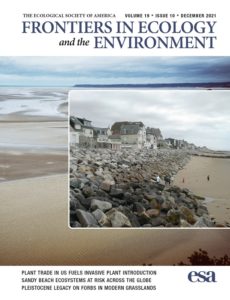Staff of Cary Institute of Ecosystem Studies writes:
Analysis of plans from 20 US cities finds definitions inconsistent and narrow. Green infrastructure has been embraced as a tool to help cities achieve sustainability and resilience goals while improving the lives of urban residents. How green infrastructure is defined guides the types of projects that cities implement, with enduring impacts to people and the urban environment.
A new nationwide analysis of 122 plans from 20 US cities, published today in Frontiers in Ecology and the Environment, found that many plans fail to explicitly define green infrastructure. When they do, they tend to focus on stormwater management, favoring engineered facilities over parks and larger urban green spaces. The study is the first systematic review of the use and definition of the green infrastructure concept in US city plans.
 Lead author Zbigniew Grabowski, who completed the work as a postdoctoral associate at Cary Institute of Ecosystem Studies, explains, “Green infrastructure is broadly understood to be a good thing, but many city plans lack a clear definition of what it actually is. Hydrological definitions dominate. This narrow view can limit project funding and cause cities to miss out on vital social and ecological services that more integrative green infrastructure can provide.”
Lead author Zbigniew Grabowski, who completed the work as a postdoctoral associate at Cary Institute of Ecosystem Studies, explains, “Green infrastructure is broadly understood to be a good thing, but many city plans lack a clear definition of what it actually is. Hydrological definitions dominate. This narrow view can limit project funding and cause cities to miss out on vital social and ecological services that more integrative green infrastructure can provide.”
Green infrastructure has its roots in 19th century landscape design. Its original conceptualization was broad, taking in parks, trail systems, gardens, and other natural landscape features that provide benefits for people and the environment. This shifted in 2007, when the US Environmental Protection Agency defined green infrastructure as a set of best practices for managing stormwater, to meet Clean Water Act regulations.
Coauthor and Cary Institute scientist Steward T.A. Pickett notes, “While the landscape concept of green infrastructure includes stormwater management benefits, stormwater concepts rarely consider the broader landscape. This can mean lost opportunities for more expansive benefits, among them high-quality green spaces, management of diverse environmental risks, and improved urban public health.”
Taking in the breadth of concepts outlined in the 122 plans, the authors developed a synthetic definition of green infrastructure to guide future research and planning, and help cities and researchers adopt a more comprehensive view of what green infrastructure entails and the benefits it confers.
Green infrastructure (GI) refers to a system of interconnected ecosystems, ecological–technological hybrids, and built infrastructures providing contextual social, environmental, and technological functions and benefits. As a planning concept, GI brings attention to how diverse types of urban ecosystems and built infrastructures function in relation to one another to meet socially negotiated goals.
Read more: Toward a more inclusive definition of green infrastructure
 Greenroofs.comConnecting the Planet + Living Architecture
Greenroofs.comConnecting the Planet + Living Architecture





